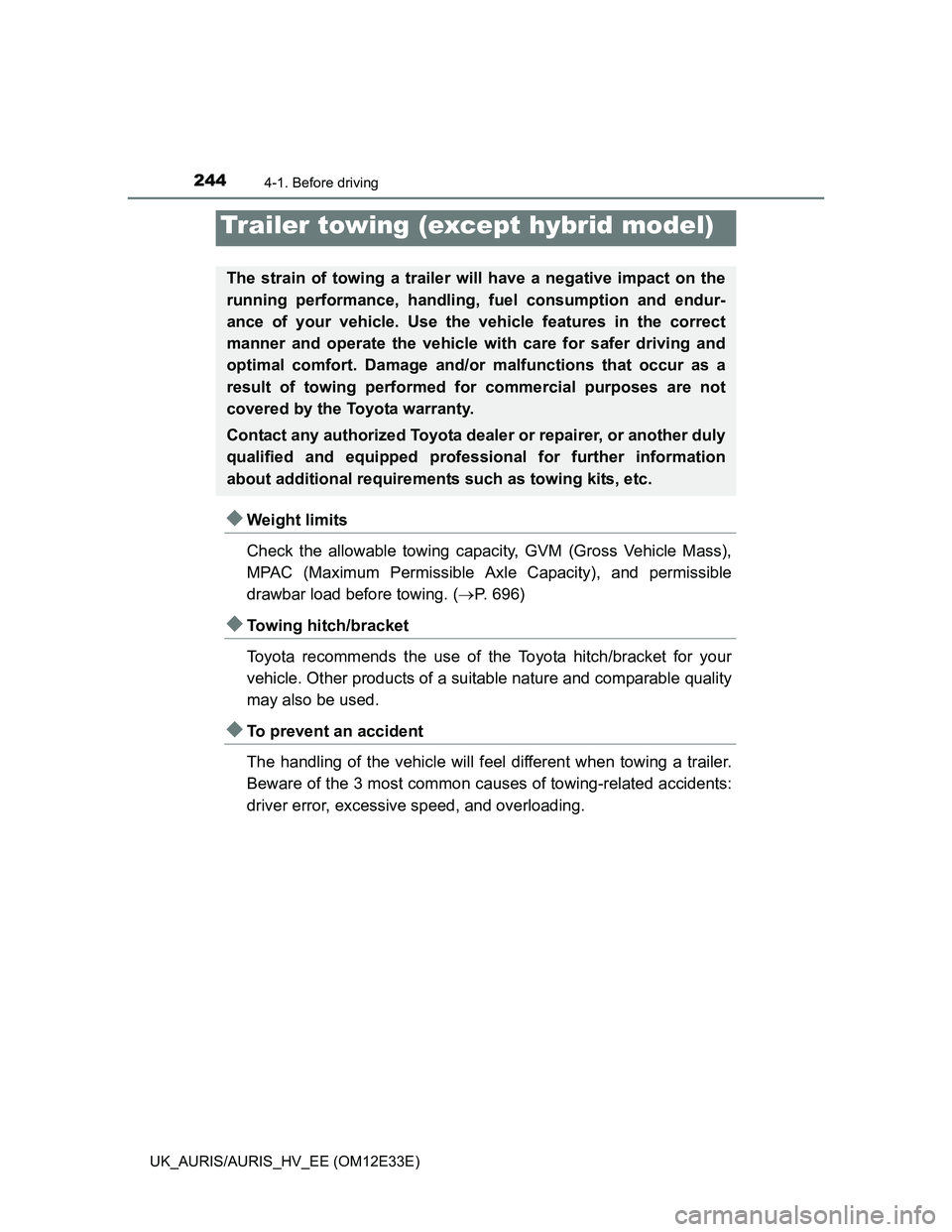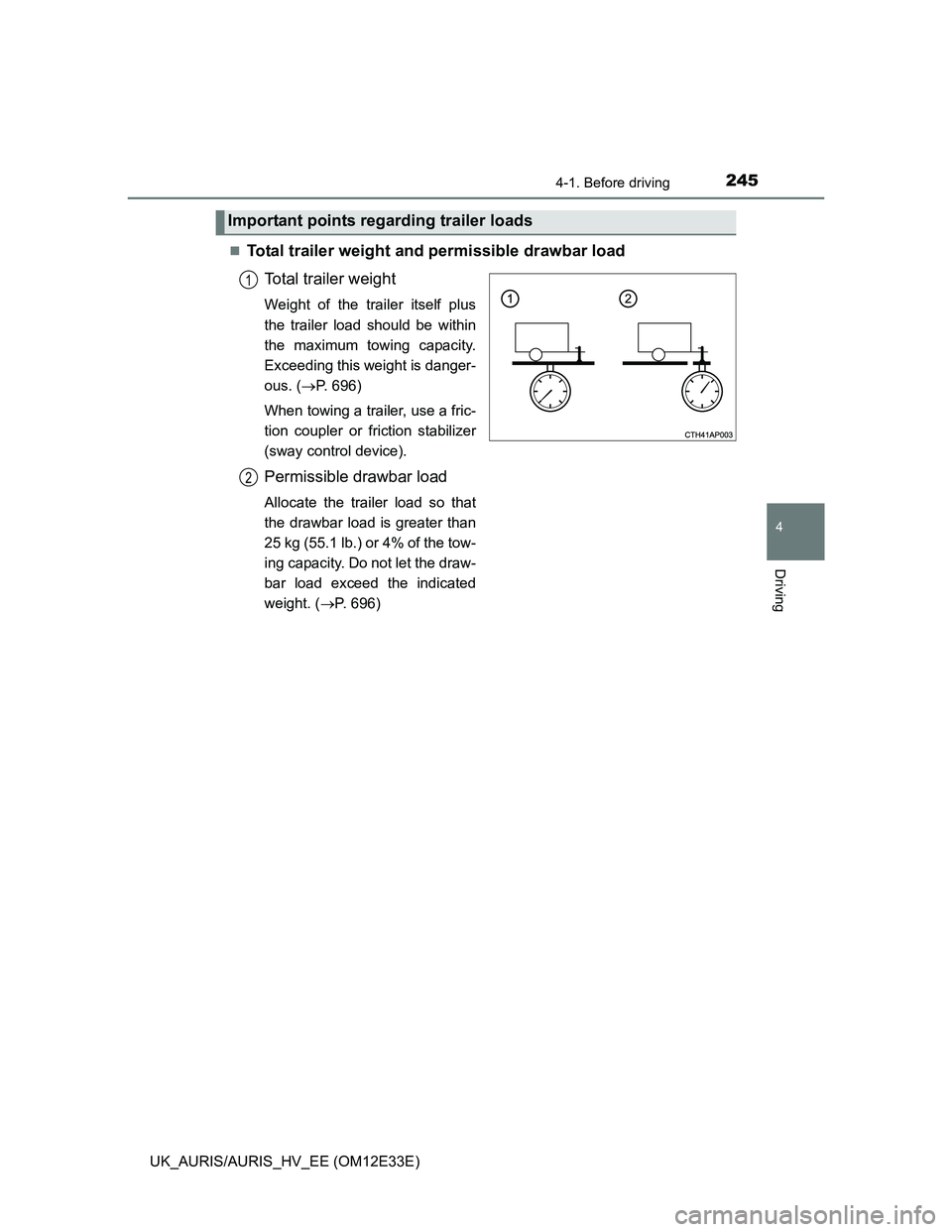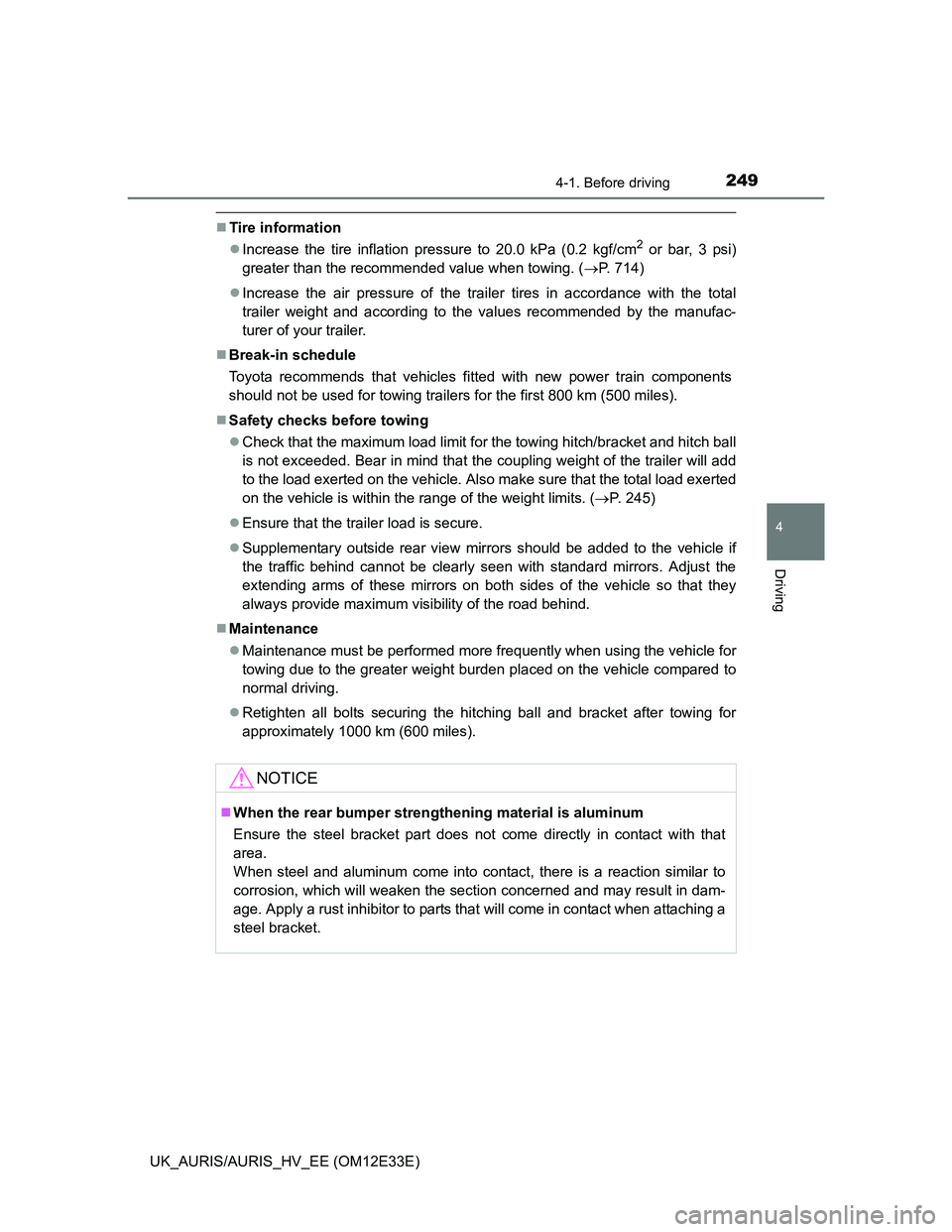2012 TOYOTA AURIS trailer
[x] Cancel search: trailerPage 5 of 750

3
1
8 7
6
5
4
3
2
UK_AURIS/AURIS_HV_EE (OM12E33E)3-5. Opening and closing the
windows
Power windows ..................220
4-1. Before driving
Driving the vehicle .............226
Cargo and luggage ............243
Trailer towing
(except hybrid model) ......244
Trailer towing
(hybrid model)..................253
4-2. Driving procedures
Engine (ignition) switch
(except hybrid model
[vehicles without a smart
entry & start system]).......254
Engine (ignition) switch
(except hybrid model
[vehicles with a smart
entry & start system]).......258
Power (ignition) switch .......268
EV drive mode ...................274
Multidrive ...........................276
Multi-mode Manual
Transmission ...................281
Manual transmission ..........286
Hybrid transmission ...........289
Turn signal lever ................297
Parking brake.....................298
Horn ...................................2994-3. Operating the lights and
wipers
Headlight switch ................ 300
Automatic High Beam ....... 306
Fog light switch ................. 310
Windshield wipers and
washer ............................ 312
Rear window wiper and
washer ............................ 316
4-4. Refueling
Opening the fuel tank
cap .................................. 318
4-5. Using the driving support
systems
Cruise control .................... 322
Speed limiter ..................... 327
Toyota parking
assist-sensor ................... 330
Simple-IPA
(Simple-Intelligent
Parking Assist) ................ 336
Stop & Start system .......... 350
Driving assist systems....... 356
Hill-start assist control ....... 362
Diesel particulate filter
system............................. 364
4-6. Driving tips
Hybrid vehicle driving
tips .................................. 366
Winter driving tips.............. 368
4Driving
Page 227 of 750

225
4Driving
UK_AURIS/AURIS_HV_EE (OM12E33E)4-1. Before driving
Driving the vehicle ............. 226
Cargo and luggage ............ 243
Trailer towing (except
hybrid model) ................... 244
Trailer towing
(hybrid model).................. 253
4-2. Driving procedures
Engine (ignition) switch
(except hybrid model
[vehicles without a smart
entry & start system])....... 254
Engine (ignition) switch
(except hybrid model
[vehicles with a smart
entry & start system])....... 258
Power (ignition) switch....... 268
EV drive mode ................... 274
Multidrive ........................... 276
Multi-mode Manual
Transmission ................... 281
Manual transmission.......... 286
Hybrid transmission ........... 289
Turn signal lever ................ 297
Parking brake .................... 298
Horn ................................... 2994-3. Operating the lights and
wipers
Headlight switch................. 300
Automatic High Beam ........ 306
Fog light switch .................. 310
Windshield wipers and
washer ............................. 312
Rear window wiper and
washer ............................. 316
4-4. Refueling
Opening the fuel tank
cap ................................... 318
4-5. Using the driving support
systems
Cruise control..................... 322
Speed limiter ...................... 327
Toyota parking
assist-sensor ................... 330
Simple-IPA
(Simple-Intelligent
Parking Assist)................. 336
Stop & Start system ........... 350
Driving assist systems ....... 356
Hill-start assist control........ 362
Diesel particulate filter
system ............................. 364
4-6. Driving tips
Hybrid vehicle driving
tips ................................... 366
Winter driving tips .............. 368
Page 232 of 750

2304-1. Before driving
UK_AURIS/AURIS_HV_EE (OM12E33E)
When starting off on a uphill (vehicles with a hill-start assist control)
The hill-start assist control is available. (P. 362)
Driving in the rain
Drive carefully when it is raining, because visibility will be reduced, the win-
dows may become fogged-up, and the road will be slippery.
Drive carefully when it starts to rain, because the road surface will be espe-
cially slippery.
Refrain from high speeds when driving on an expressway in the rain,
because there may be a layer of water between the tires and the road sur-
face, preventing the steering and brakes from operating properly.
Engine speed while driving (vehicles with a Multidrive)
In the following conditions, the engine speed may become high while driving.
This is due to automatic up-shifting control or down-shifting implementation to
meet driving conditions. It does not indicate sudden acceleration.
The vehicle is judged to be driving uphill or downhill
When the accelerator pedal is released
With the Sport Mode switch activated, when the brake pedal is depressed.
Breaking in your new Toyota (except hybrid model)
To extend the life of the vehicle, observing the following precautions is recom-
mended:
For the first 300 km (186 miles):
Avoid sudden stops.
For the first 800 km (500 miles):
Do not tow a trailer.
For the first 1000 km (621 miles):
• Do not drive at extremely high speeds.
• Avoid sudden acceleration.
• Do not drive continuously in low gears.
• Do not drive at a constant speed for extended periods.
Page 246 of 750

2444-1. Before driving
UK_AURIS/AURIS_HV_EE (OM12E33E)
Weight limits
Check the allowable towing capacity, GVM (Gross Vehicle Mass),
MPAC (Maximum Permissible Axle Capacity), and permissible
drawbar load before towing. (P. 696)
Towing hitch/bracket
Toyota recommends the use of the Toyota hitch/bracket for your
vehicle. Other products of a suitable nature and comparable quality
may also be used.
To prevent an accident
The handling of the vehicle will feel different when towing a trailer.
Beware of the 3 most common causes of towing-related accidents:
driver error, excessive speed, and overloading.
Trailer towing (except hybrid model)
The strain of towing a trailer will have a negative impact on the
running performance, handling, fuel consumption and endur-
ance of your vehicle. Use the vehicle features in the correct
manner and operate the vehicle with care for safer driving and
optimal comfort. Damage and/or malfunctions that occur as a
result of towing performed for commercial purposes are not
covered by the Toyota warranty.
Contact any authorized Toyota dealer or repairer, or another duly
qualified and equipped professional for further information
about additional requirements such as towing kits, etc.
Page 247 of 750

2454-1. Before driving
UK_AURIS/AURIS_HV_EE (OM12E33E)
4
Driving
Total trailer weight and permissible drawbar load
Total trailer weight
Weight of the trailer itself plus
the trailer load should be within
the maximum towing capacity.
Exceeding this weight is danger-
ous. (P. 696)
When towing a trailer, use a fric-
tion coupler or friction stabilizer
(sway control device).
Permissible drawbar load
Allocate the trailer load so that
the drawbar load is greater than
25 kg (55.1 lb.) or 4% of the tow-
ing capacity. Do not let the draw-
bar load exceed the indicated
weight. (P. 696)
Important points regarding trailer loads
1
2
Page 249 of 750

2474-1. Before driving
UK_AURIS/AURIS_HV_EE (OM12E33E)
4
Driving
*: To distinguish the vehicle category, ask any authorized Toyota dealer or
repairer, or another duly qualified and equipped professional.
CAUTION
Vehicle category M1 models*: When the gross vehicle mass limit or
maximum permissible axle capacity is exceeded
Do not exceed the established speed limit for towing a trailer in built-up
areas or 100 km/h (62 mph), whichever is the lower.
Failing to observe this precaution may lead to an accident causing death or
serious injury.
Page 251 of 750

2494-1. Before driving
UK_AURIS/AURIS_HV_EE (OM12E33E)
4
Driving
Tire information
Increase the tire inflation pressure to 20.0 kPa (0.2 kgf/cm
2 or bar, 3 psi)
greater than the recommended value when towing. (P. 714)
Increase the air pressure of the trailer tires in accordance with the total
trailer weight and according to the values recommended by the manufac-
turer of your trailer.
Break-in schedule
Toyota recommends that vehicles fitted with new power train components
should not be used for towing trailers for the first 800 km (500 miles).
Safety checks before towing
Check that the maximum load limit for the towing hitch/bracket and hitch ball
is not exceeded. Bear in mind that the coupling weight of the trailer will add
to the load exerted on the vehicle. Also make sure that the total load exerted
on the vehicle is within the range of the weight limits. (P. 245)
Ensure that the trailer load is secure.
Supplementary outside rear view mirrors should be added to the vehicle if
the traffic behind cannot be clearly seen with standard mirrors. Adjust the
extending arms of these mirrors on both sides of the vehicle so that they
always provide maximum visibility of the road behind.
Maintenance
Maintenance must be performed more frequently when using the vehicle for
towing due to the greater weight burden placed on the vehicle compared to
normal driving.
Retighten all bolts securing the hitching ball and bracket after towing for
approximately 1000 km (600 miles).
NOTICE
When the rear bumper strengthening material is aluminum
Ensure the steel bracket part does not come directly in contact with that
area.
When steel and aluminum come into contact, there is a reaction similar to
corrosion, which will weaken the section concerned and may result in dam-
age. Apply a rust inhibitor to parts that will come in contact when attaching a
steel bracket.
Page 252 of 750

2504-1. Before driving
UK_AURIS/AURIS_HV_EE (OM12E33E)
Your vehicle will handle differently when towing a trailer. In order to
avoid accident, death or serious injury, keep the following in mind
when towing:
Checking connections between trailer and lights
Stop the vehicle and check the operation of the connection between
the trailer and lights after driving for a brief period as well as before
starting off.
Practicing driving with a coupled trailer
Get the feel for turning, stopping and reversing with the trailer
coupled by practicing in an area with no or light traffic.
When reversing with a coupled trailer, hold the section of the
steering wheel nearest to you and rotate clockwise to turn the
trailer left or counterclockwise to turn it right. Always rotate a little
at a time to prevent steering error. Have someone guide you
when reversing to lessen the risk of an accident.
Increasing vehicle-to-vehicle distance
At a speed of 10 km/h (6 mph), the distance to the vehicle running
ahead of you should be equivalent to or greater than the combined
length of your vehicle and trailer. Avoid sudden braking that may
cause skidding. Otherwise, the vehicle may spin out of control. This
is especially true when driving on wet or slippery road surfaces.
Sudden acceleration/steering input/cornering
Executing sharp turns when towing may result in the trailer colliding
with your vehicle. Decelerate well in advance when approaching
turns and take them slowly and carefully to avoid sudden braking.
Important points regarding turning
The wheels of the trailer will travel closer to the inside of the curve
than the wheels of the vehicle. To make allowance for this, take the
turns wider than you would normally do.
Guidance